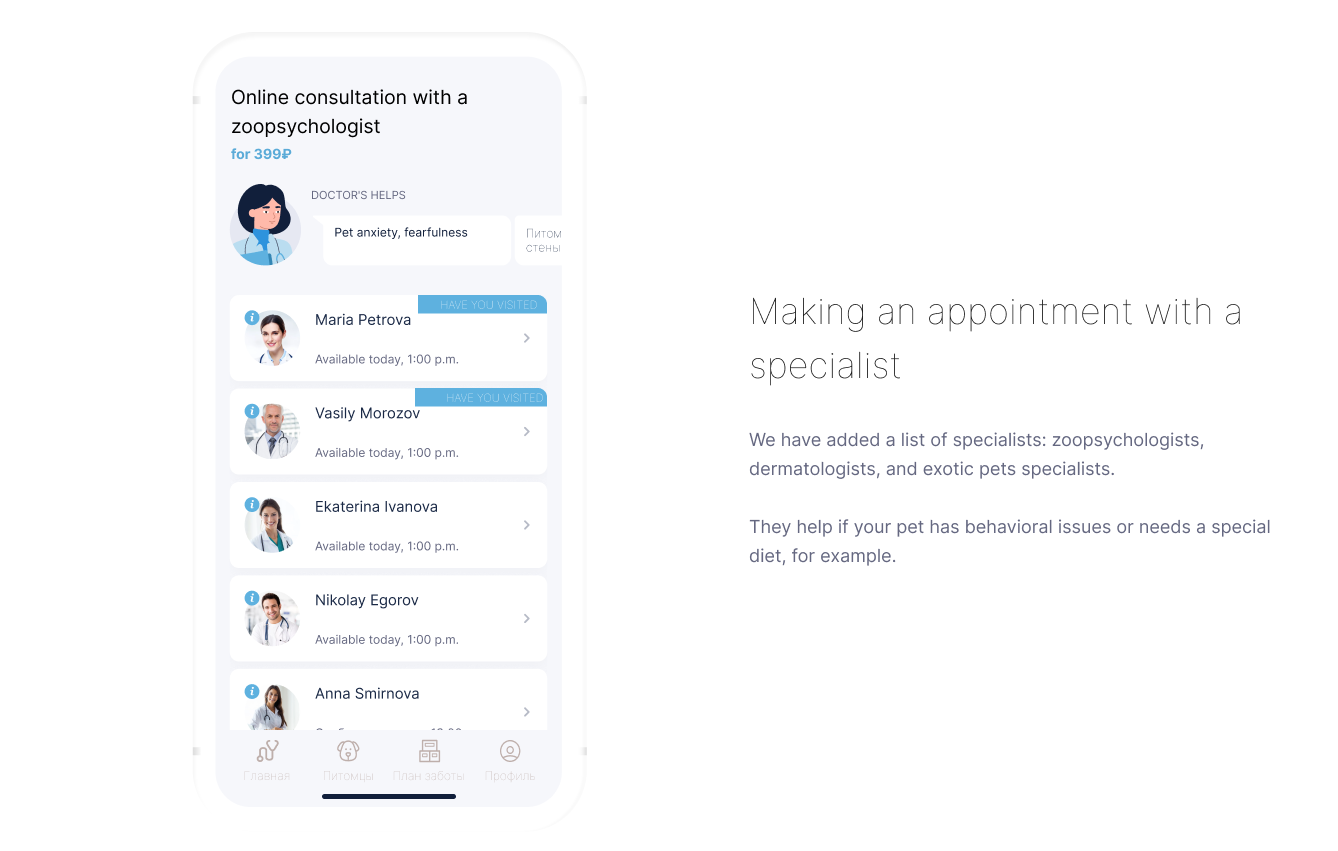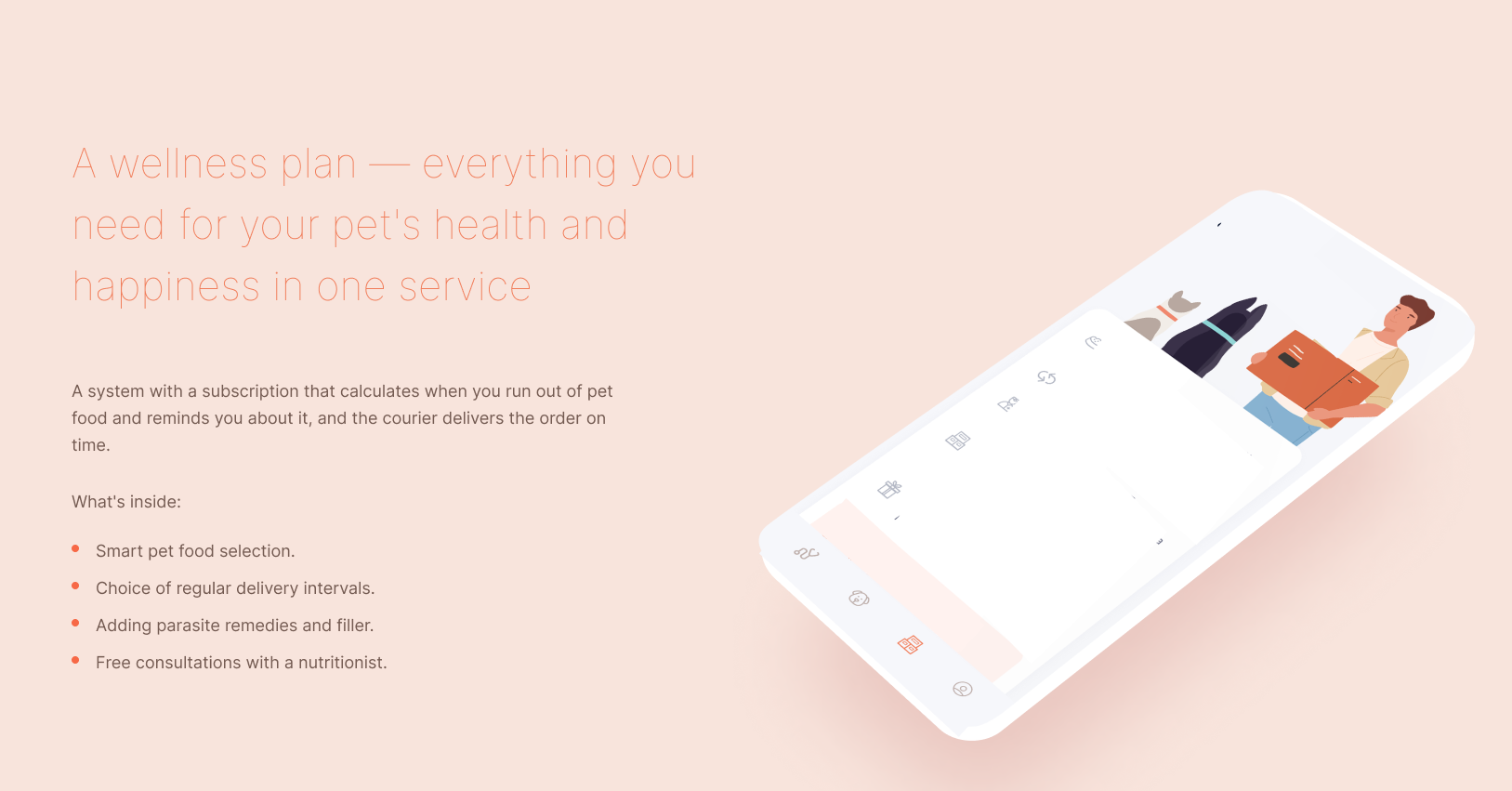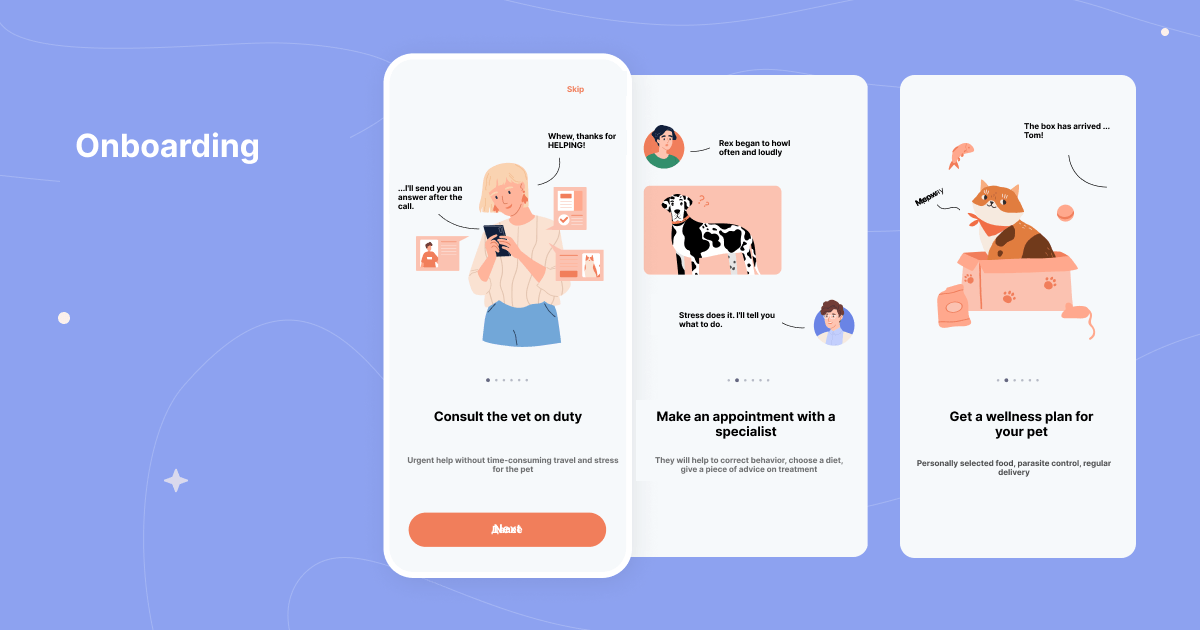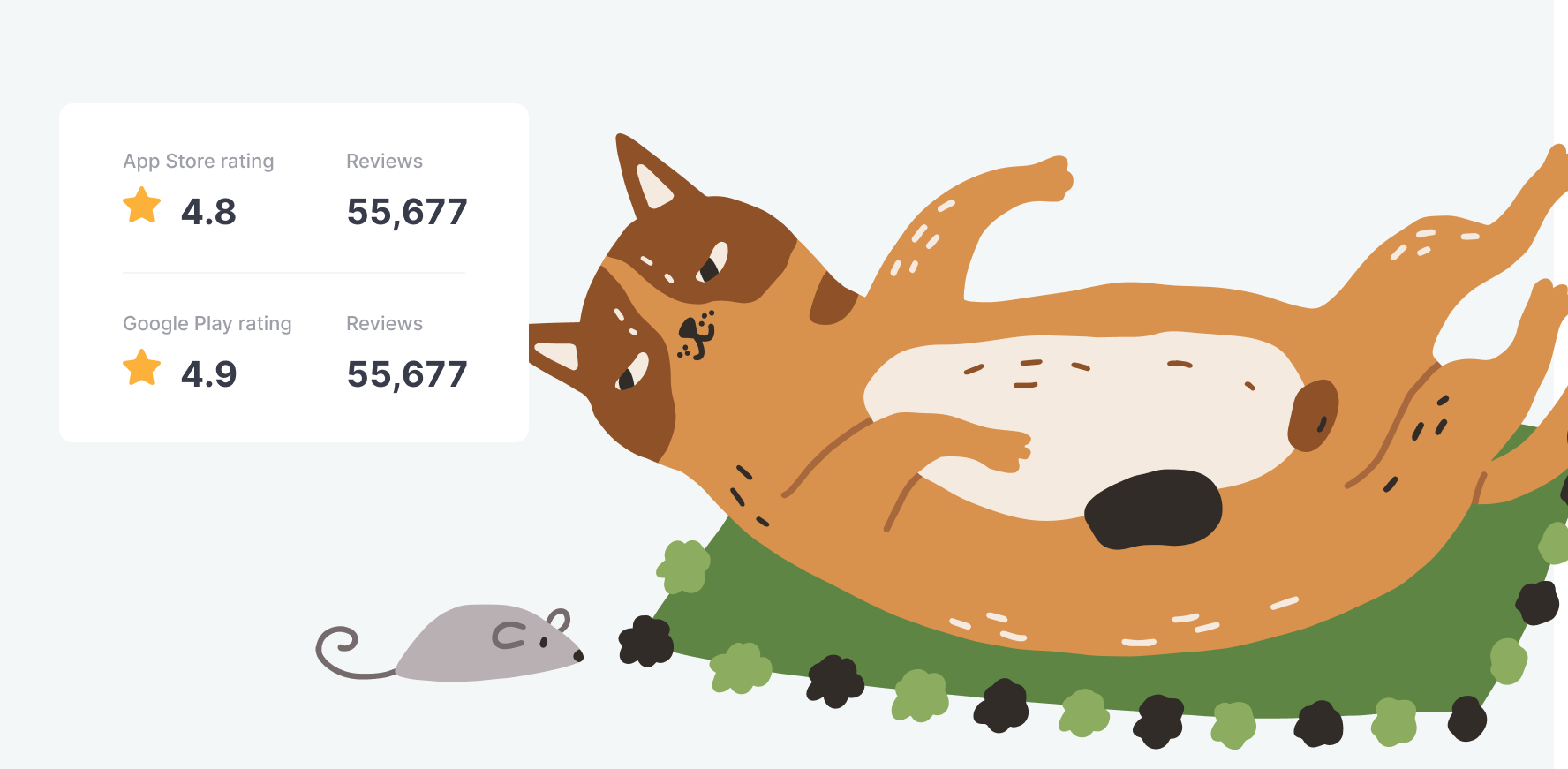Hello! We’re IMAGA, and we’ve been helping Mars develop the Petstory app for the past 2 years. Today it is a popular PetTech service allowing dog and cat owners to consult with veterinarians online and keep pets’ medical records. There are already more than 600,000 downloads of the app, it has more than 8,000 reviews in the AppStore and Google Play with a rating of 4.8. However, it took us a while to choose the right path for its development.
We and Mars share a product team. Each specialist, regardless of their role, position, or company, tries to make the app as user-friendly and business-friendly as possible, that’s why the article is written in the first person. From the IMAGA and the Petstory team.
In the process, we changed our ideas about the product several times. We were learning how to maneuver between business interests and users’ interests, and tried to understand what products pet owners would like to have. As a result, we gathered enough data and insight so that the app could fully complement care in offline clinics.
We’ll tell you now what we got right and what we got wrong.
HOW WE JOINED THE PROCESS AND ASSEMBLED A PRODUCT TEAM
Mars launched a website for pet owners back in 2017. At first, it was supposed to make vet appointments easier and help pet owners keep track of their pets’ health. But the idea was quickly abandoned. The clinics were not ready for complex technical integrations, so the company decided to make consultations online.
Mars approached us when they already had some basis: the app could be downloaded from the store, but making an appointment was only possible for an online consultation with a vet and for offline clinics. Meanwhile, user requests were growing every day. Now, we’re going to describe the features we’ve released together and the processes we’ve built up. Together we had to figure out what the application should look like and how to organize the work on the project so that everyone would feel comfortable.
We started with the organization of the work.
There is an unofficial division of responsibility within the project. Mars guys are in charge of product management and product analytics, while we are responsible for the design, system analytics, and development. IMAGA also has product and web analytics involved in the development of the app. You should keep this in mind when reading the article. Usually, everyone on the team can influence the entire app.
We avoid the customer—contractor relationship. Honestly, we don’t even use these words. My task as a product manager is to create a united and strong team, which will think together about the product and influence it even in the smallest details. In this respect, it doesn’t matter to me which company some of the team members are employed by. We’re working toward the same goal, and we can feel it."
The team uses a Scrum framework, which includes usual things: two-week sprints, daily Scrum meetings, demos, and retrospectives. Once every two weeks, we hold meetings to present the results to business customers. Retrospectives deserve a separate article. We record the results of these meetings in Confluence.
HOW WE DEVELOPED VIDEO CONSULTATIONS
The first thing we had to do was to tweak online consultations. Now you can get help in the app in two ways::
- Contact an on-call therapist, who is available from 6 am to 2 am This option is appropriate if you need an urgent consultation.
- Make an appointment with a specialist or a vet
They have a personal calendar in the app, in which the available slots are marked. This is a nice option when you need to plan your day.

The app used to have only online vet consultations, and it certainly didn’t cover all the users’ needs. For some users, it was quite a novelty to get a chance to talk to a nutritionist, a zoopsychologist, and a dermatologist. These specialists are usually hard to find and few know about them, let alone the opportunity to talk to them online. You can talk to doctors in whatever way you prefer: by voice, chat, or video call. Much of the credit for the user’s love of the service goes to a particularly important employee, the care manager, Lera. She is responsible for working with users (responding to feedback in storerooms, as well as fixing bugs in the system and sending it for debugging) and technical support for doctors. This increases the speed of doctors’ sign-ups on the platform: without Lera, it would take 1–2 days, but with her, it takes no more than 30 minutes. It also helped to fill the backlog consistently.
It’s great that I can talk to doctors directly, it saves a lot of time for both the business and doctors. I can solve 95% of vet questions. Also, it’s nice that people use the app and write feedback, which we then process and make improvements.
HOW WE CAME UP WITH THE WELLNESS PLAN
The original idea was to create an ecosystem, a kind of super-app for pet owners.
Petstory already had a quality online vet service. We were looking for a product that would solve a more common problem, increase the frequency of the app usage, and improve the customer lifetime value. We knew that 90% of pet costs were related not to their medical treatment but to their nutrition. It turned out that owners did not know which feed to choose. However, a pet’s health, longevity, and quality of life greatly depend on the right choice of feed and portions.
That’s why we came up with the idea of a healthy food subscription, a plan of care. This service was intended to help pet owners to choose and regularly buy pet food, as well as to let each owner properly care for their pet and prolong its active life.
The product team conducted some qualitative studies through a series of interviews and an online focus group. The purpose was to understand users’ challenges and struggles related to nutrition and health care to identify features for the new product MVP. We selected respondents both from current users of the app and from the target audience of pet owners. Then the resulting hypotheses were tested quantitatively with audience surveys. To increase accuracy, respondents were asked to leave their contact to be notified when the service would be ready. It helped to understand which product concept interested users more.
For example, research has shown that many people want to include parasite control in their subscriptions. The result was an image of a product that would allow you to get everything you need for your pet on a subscription basis. That product was the wellness plan.
HOW IT WORKS
You need to enter the pet’s data in the app: weight, age, breed, etc. The program will make up the optimal diet, and if necessary, a dietitian will consult you for free. A box-house with a set of healthy food, remedies for parasites and a toy will be delivered to your house before the last portion of pet food runs out, about once a month. Push notifications will remind you that a package is coming soon or that your pet needs anti-parasite treatment.

The algorithm takes into account the weight, age, breed, and specifics of the pet — whether it is neutered/castrated, what kind of behavior it has. You can also specify your pet’s feeding preferences (dry or dry+wet) and food type (Holistic, super-premium, pedigree). On the basis of this data, the algorithm selects the food. What’s even more interesting is how we modernized the algorithm for puppies and kittens. They grow very fast, but at different rates in different breeds. We collected data on weight changes in different breeds of kittens and puppies and made an algorithm that predicts their weight changes. The algorithm recalculates their feeding rate for one day and changes the delivery interval based on these changes.
When we first introduced the wellness plan, it was only available on mobile devices. But after studying the conversion data, we saw that new users check the features of the service through the website before downloading the app. That's why we added the option to sign up for the wellness plan there, too. However, according to statistics, after the first use of the service the client turns their attention to the mobile application, and then they use only it. In the first year after the launch, we made many changes and improvements to the product (for example, convenient subscription management) and delivered several thousand kits to cats and dogs. Users like the service — about 15% of customers post photos and videos of the kit on social networks recommending it to friends.
NINE MICROSERVICES WITH DEDICATED SERVERS: HOW PETSTORY LOOKS FROM THE INSIDE
In the beginning, the project had a microservice architecture to reduce the time it takes to develop features.
Each feature was developed separately and then integrated into the product. The app now consists of nine microservices with dedicated servers. They are responsible for payments, file storage, user’s authorization, analytics, etc.
Advantages of this solution include not only the speed of development but also the security of the application, which means if something fails in one of the services, all the others continue to work. But there were downsides as well.
In the beginning of development, the microservice architecture seemed promising: high scalability, ease to develop in the team, and simple in testing. However, as the product grew, problems began to emerge such as constant refactoring, functionality that belongs to several microservices, so it is not clear where to ’put’ it, difficulties in development, when for one small feature you have to fix several services at once. We have tried several solutions, but the most reasonable one is to monolith business logic, keeping as microservices only those parts that do not change and work perfectly atomically: analytics, authorization, file storage.
We will talk in more detail about microservices and combining them into a monolith in our blog on Habr.
As for third-party services, we use some of them. Voxiplant is used for video consultations, CloudPayments for payment, and Yclients for recording online consultations. The logic here is simple: why should we invent something new if we can integrate existing and suitable solutions. It saves time and resources.
Although doubts about Yclients have been around for a long time. Because it is a third-party service, it takes a long time to update the schedule. So we have to keep a data cache of free and occupied slots. Some mistakes still occur: the user can see that some slot is available, but it is already occupied, and vice versa. We thought about developing our own appointment service, but in the end, we found another way out. Now, if necessary, the cache is cleaned by itself after updating the schedule on Yclients. There are no mistakes, all pets’ owners get counseled exactly on time and on schedule.
HOW WE RETAIN USERS
To better understand the clients’ needs, we constantly conduct a lot of A/B-tests. They help us figure out what animal owners are mostly interested in first, what comes second, and what doesn’t interest them at all. This makes the app more user-friendly.

Through tests, we found out what is more important for users — a discount or a smart algorithm for selecting food (it turned out that the discount), a here-and-now consultation or an appointment (both variants are fine), and so on. We even tested what a finished set of wellness plans should look like. We were sure that everyone wanted all the items in the set laid out in blocks. But the test showed that people like everything put together.
Many design decisions also go through testing: for example, we used audience reaction to see which app icon people liked more.
For the owner of a cat or dog to prefer us to the usual veterinary clinic, they must understand at every step what the application means to them. This is one of the important elements of our design. We always draw the user’s attention to our advantages: prices, doctors’ qualification, being able to get help here and now, and unique services.
For a very long time, we have been under the delusion that we can’t use Apple Pay and Google Pay to cover wellness plan subscriptions, because using that payment method requires regular payment confirmation by the user. Our job was to make taking care of the pet as easy as possible. Eventually, we found a solution and launched this functionality. Now it’s even easier for the user to pay for a subscription. There is no need to enter card and CVC data every time."
Another feature we implemented after the survey is a pet events calendar. We don't just fill in your pet's profile with age and vaccinations (as we used to). We keep a full calendar of things to do. Petstory will even let you insure your pet. To do this, Mars partnered with two insurance companies . One insures adult animals and the other insures puppies and kittens.
Eventually, we got users to come back to the app more often. In 2019, the repeat visit rate was 7%. This number has now reached 53%. By comparison, in the offline clinic, the number is 60%.
WHAT RESULTS HAVE BEEN ACHIEVED
The app has been downloaded more than 600,000 times since it was released on iOS and Android. Petstory now has about 50,000 active users.

The growth of the audience was significantly affected by the events of 2020: the pandemic and total remote work. The number of active users grew by 1.5 times.
In the next big iterations, we plan to pay attention to the b2b sector. As for the exact plans, we will discuss them at the next strategic sessions. But we will proceed from the needs of our furry patients, of course.